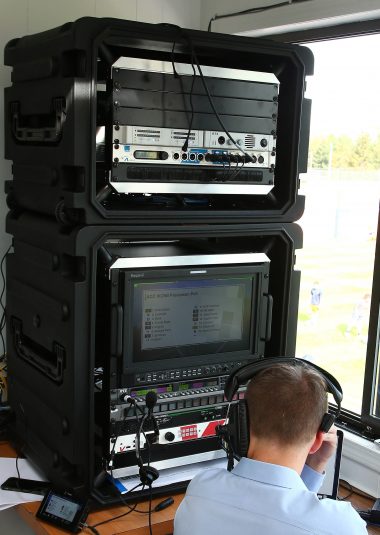Syracuse University Rolls Out IP for Teaching, ACC Coverage
$18 million renovation at Newhouse School targets evolving sports broadcasting
Story Highlights
As traditional broadcast sports barrels toward an IP-based future, some of the parallel collegiate efforts seem to be moving even faster. In little more than a month over the summer, Syracuse University’s athletics and broadcast-journalism departments collaborated on a new fiber backbone connecting five sports venues used for soccer, field hockey, volleyball, ice hockey, and softball; and the 49,000-seat Carrier Dome, home to the school’s Orange football, basketball, and lacrosse teams; with three new primary control rooms in the university’s S.I. Newhouse School of Public Communications.
The fiber backbone is part of an $18 million, three-year renovation at the Newhouse School, which included the launch of the Dick Clark Studios and Alan Gerry Center for Media Innovation. The new infrastructure, which also includes a Lawo mc²56 mixing console and Nova73 router, is designed to support both the school’s effort to better prepare students for broadcast’s incipient IP-based landscape and the school’s participation in the Atlantic Coast Conference Network (ACC) and, by extension, with ESPN, the conference’s exclusive worldwide-rights holder through 2039.
“The goal is to produce approximately 70 games this current academic year,” says Neal Coffey, manager, operations and engineering, Dick Clark Studios, noting that the idea for the fiber network was hatched with colleagues on a bar napkin seven years ago. “As of late October, we have produced 24 games that include men’s and women’s soccer, field hockey, and volleyball. This is a great real-world laboratory for our faculty members to teach in.”
REMI on the Horizon
The two goals are synergistic and target an at-home or REMI remote-production model. Coffey says the school had retired its remote-production truck over a decade ago in favor of AV flypacks at each venue but with the backhaul still largely over copper cabling. Now each venue has five or six camera fiber drops with a dozen strands of single-mode fiber — including 24 to the press boxes for 278 strands in total — running the approximately two miles from the Newhouse School south to the venues and a half mile to the Carrier Dome.
“We no longer have to take the control room to the venue and can now connect multiple venues to a central control room,” Coffey explains.
The venues feature two Lawo V_remote 4 units (announcer replay and official replay), a Lawo LCU commentary unit, and Lawo A_line and A_mic8 for EFX mics. The three control rooms — which can access Lawo V_remote4 units (announcer replay and official replay) and two V_pro8 units (for the Evertz DreamCatcher replay embedder/de-embedder), as well as 11 32-TB Avid ISIS chassis video-file–storage systems for postproduction — are interchangeable and are staffed with a combination of students; a cadre of broadcast-experienced instructors, including Director of Athletics and former ESPN executive John Wildhack (he produced ESPN’s first live regular-season college-football game in September 1984 and its first live NFL game in August 1987) and Newhouse Sports Media Center Director Olivia Stomski, who has also held various editing and producing positions at Fox Sports Net; and local ESPN freelancers.
Coffey says the goal is that, in the near future, students will largely run the operation under instructors’ supervision.
“This all came together so quickly,” he adds. “It’ll take us two years to build up the critical student skills we need. For instance, we have 16 channels of DreamCatcher for replays, and it’ll take a while to get up to full speed on platforms like that. But we’re already starting to put students into critical positions — on cameras, as producers and directors — and much of the on-air color and commentary is being done by students, except basketball; here, we use professionals.”
The new broadcast-sports initiative at Syracuse University moved onto a network quickly — so fast that the separate fiber infrastructure was necessary to free the sports media from the school’s larger but less nimble IT infrastructure — but, says Coffey, the rate of change in the industry his students will have to break into demands it.
“We’ve advanced very far in a short period,” he points out. “But we’re still developing our own understanding of the complexities of all this. Fortunately, we have a lot of good people working with us. This is just the beginning of this exciting initiative.”

